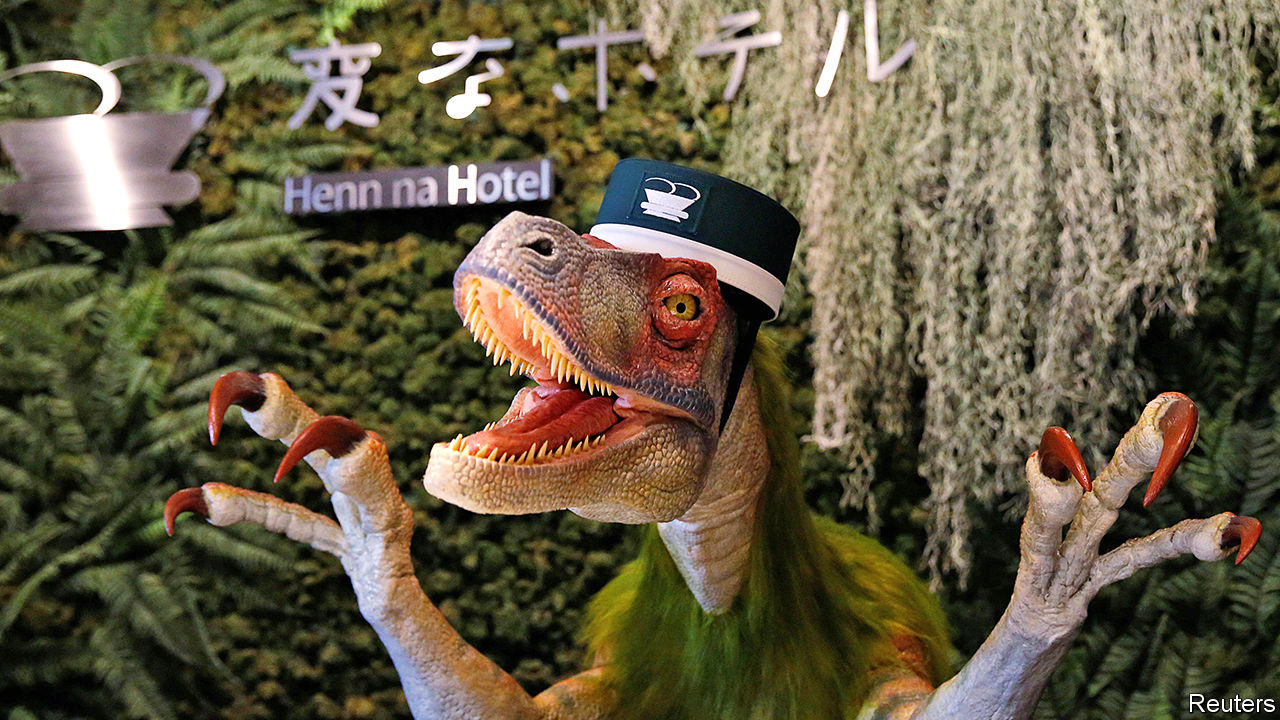
Japan is both obsessed with and resistant to robots

HOTEL RECEPTIONISTS are rarely this intimidating. Yellow eyes glare as the room number is snarled through razor-sharp teeth. The mechanical T-Rex behind the counter is one of nine types of robot whirring and clicking through the building, from the silicon fish that swim around a tank in the lobby to the egg-shaped concierge that controls the lights and heating in each of the 100 rooms. There is not a human in sight.
Machines already do much of the dangerous and repetitive work in Japanese factories, which have one of the highest densities of industrial robots in the world: 303 per 10,000 employees. As the population declines, Japan’s vast service industry will also automate, predicts Hiroshi Ishiguro, a roboticist at Osaka University. Robots will look after the elderly, teach children and read the evening news. Television anchors resemble androids anyway, he jokes.
Yet the future has been slow to arrive. Japanese hotels and banks are, by global standards, heavily overstaffed despite the country’s demographic crunch. Most supermarkets have not embraced the automated checkouts common elsewhere, nor airlines self-service check-ins. The offices of Japan’s small and medium-sized enterprises are among the most inefficient in the developed world, chides McKinsey, a management consultancy.
Japan has an elaborate service culture, which machines struggle to replicate. Japanese customers, especially the elderly, strongly prefer people to machines, says Yoko Takeda of Mitsubishi Research Institute, a think-tank. Employment practices make it difficult to replace workers. And while gimmicky robots abound, Japan struggles to develop the software and artificial intelligence needed to enable them to perform useful tasks, says a report by the Ministry of Economy, Trade and Industry (METI), the cockpit of Japan’s post-war miracle. So while the reception at the robot hotel is automated, seven human employees lurk out of sight to watch over customers and avoid glitches. Robots still cannot make beds, cook breakfast or deal with a drunken guest who will not pay his bill.
Ever fretful about declining competitiveness, METI is calling for ideas for robots to help run “department stores, beauty salons, hotels and restaurants.” There is some urgency. At 2.3%, the unemployment rate is at its lowest since 1993; in some industries there are seven vacant jobs for every applicant. Shinzo Abe, the prime minister, wants to admit 500,000 guest workers by 2025. But it is a hard sell. Conservative newspapers rail against the prospect of a Chinese immigrant on every street; a recent TV show about police hunting down illegal immigrants was a hit.
The shortage of workers, local and foreign, may at last force companies to automate, says Ken Ogata, president of Koureisha, a dispatch company whose employees are all over 60. Insurance firms have begun replacing clerks with software. A driverless taxi service is planned for Tokyo in time for the Olympics in 2020. Last year Japan’s three biggest banks announced that they will close hundreds of branches and eliminate 32,000 jobs in the coming decade. A report published in 2015 by Nomura Research Institute, another think-tank, says half of Japan’s workers could be replaced by robots within 20 years. The most vulnerable professions, it says, are those dominated by systematic, repetitive tasks, such as train drivers and security guards.
By 2030, as robots and AI eliminate such jobs, Ms Takeda forecasts, Japan will have a surplus of lowlier workers. She still believes immigrants will be needed, but only in certain skilled professions. Hotel receptionists, a colleague predicts, will have gone the way of the dinosaur.
